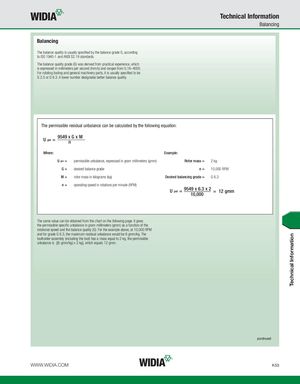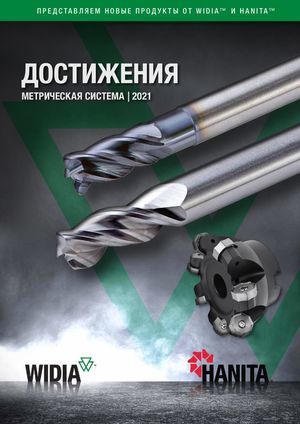Каталог Widia инструментальная оснастка - страница 1089
Навигация

Technical Information Balancing Balancing The balance quality is usually specified by the balance grade G, according to IS0 1940-1 and ANSI S2.19 standards. The balance quality grade (G) was derived from practical experience, which is expressed in millimeters per second (mm/s) and ranges from 0,16–4000. For rotating tooling and general machinery parts, it is usually specified to be G 2.5 or G 6.3. A lower number designates better balance quality. The permissible residual unbalance can be calculated by the following equation: U per = 9549 x G x Mn Where: Example: U per = permissible unbalance, expressed in gram millimeters (gmm) Rotor mass = 2 kg G= desired balance grade n= 10,000 RPM M= rotor mass in kilograms (kg) Desired balancing grade = G 6.3 n= operating speed in rotations per minute (RPM) U per = 9549 x 6.3 x 210,000= 12 gmm The same value can be obtained from the chart on the following page. It gives the permissible specific unbalance in gram millimeters (gmm) as a function of the rotational speed and the balance quality (G). For the example above, at 10,000 RPM and for grade G 6.3, the maximum residual unbalance would be 6 gmm/kg. The toolholder assembly (including the tool) has a mass equal to 2 kg, the permissible unbalance is [(6 gmm/kg) x 2 kg], which equals 12 gmm. (continued) WWW.WIDIA.COM K53 Technical Information
 Каталог Widia достижения 2021
Каталог Widia достижения 2021 Брошюра Widia решения для аэрокосмической промышленности
Брошюра Widia решения для аэрокосмической промышленности Брошюра Widia техническое руководство
Брошюра Widia техническое руководство Каталог Widia токарный инструмент 2020
Каталог Widia токарный инструмент 2020 Каталог Widia цельные концевые фрезы
Каталог Widia цельные концевые фрезы Каталог Widia техническое руководство по разверткам
Каталог Widia техническое руководство по разверткам